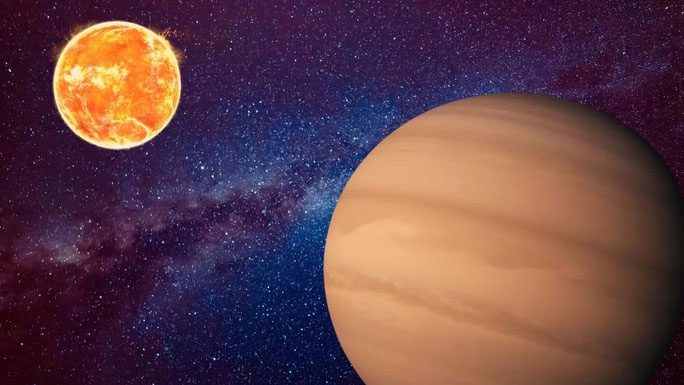The discovery of TOI-4860 b – a “monster” planet orbiting a small, light red dwarf star – has simultaneously challenged numerous astronomical theories.
TOI-4860 b is a giant gas planet classified as a “warm Jupiter”, as it is large and heavy like Jupiter but has a warm temperature due to its close proximity to its parent star.
Its “parent” is a low-mass red dwarf star – the smallest and “coolest” type of star – named TOI-4860, located in the constellation of Ophiuchus.

Red dwarf star TOI-4860 and its giant “child” TOI-4860 b – (Graphic: Robert Lea).
Notably, it seems implausible for a red dwarf star to produce a large planet like TOI-4860 b, which has a diameter about 3/4 that of Jupiter.
It is even more surprising that TOI-4860 b is enriched with a high metallicity.
“According to the ‘standard’ planet formation model, the smaller the star’s mass, the less material the surrounding disk has. Since planets form from that disk, it is believed that large, Jupiter-like planets cannot form around low-mass stars” – said Dr. George Dransfield from the University of Birmingham, a member of the research team, as quoted by Space.
TOI-4860 is the lowest-mass star known to have a giant “child” in the scientific community.
The planet TOI-4860 b was first discovered by NASA’s TESS spacecraft, a renowned “exoplanet hunter”.
By utilizing additional data from the SPECULOOS Observatory within the Paranal Observatory system located in the Atacama Desert of Chile and the Subaru Telescope in Hawaii, scientists have delved deeper into the mysteries of this planet, proposing plausible scenarios about its origin.
“One clue is hidden within the planet’s characteristics, which are particularly rich in heavy elements. We also found something similar in the parent star,” stated Professor Amaury Triaud from the University of Birmingham, the research team leader.
This abundant presence of heavy elements could act as a catalyst for the formation of this unique planet.
The short orbital period of TOI-4860 b, combined with the properties of its parent star, such as its high metallicity, has resulted in it having an oversized offspring compared to what similar stars can produce.
However, this is merely a hypothesis; the final answer remains shrouded in mystery. The research team has indicated plans to use data from another ground-based super telescope, the Very Large Telescope (VLT) located in the Atacama Desert of Chile, to search for similar pairs, thereby seeking a more concrete explanation.


















































